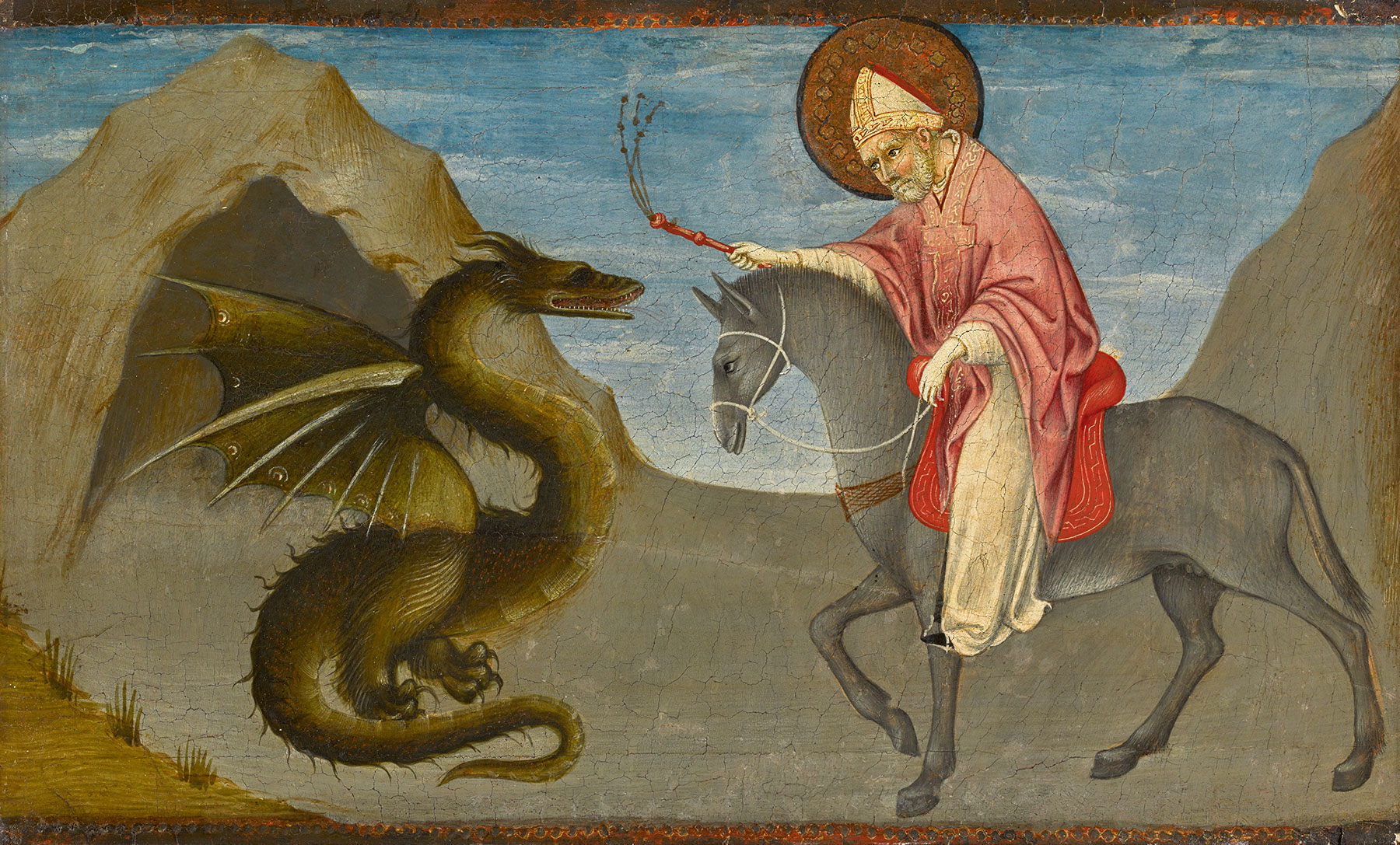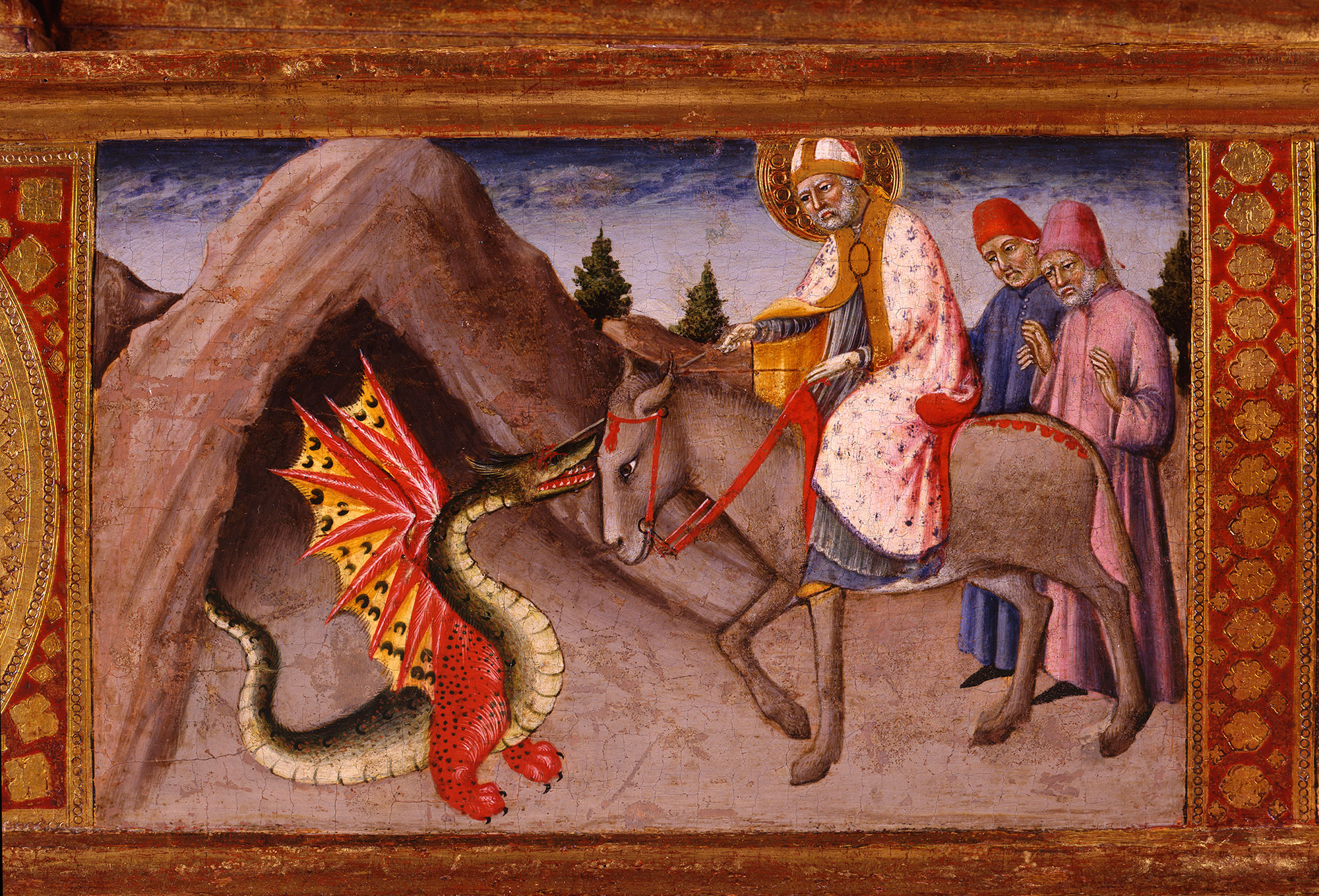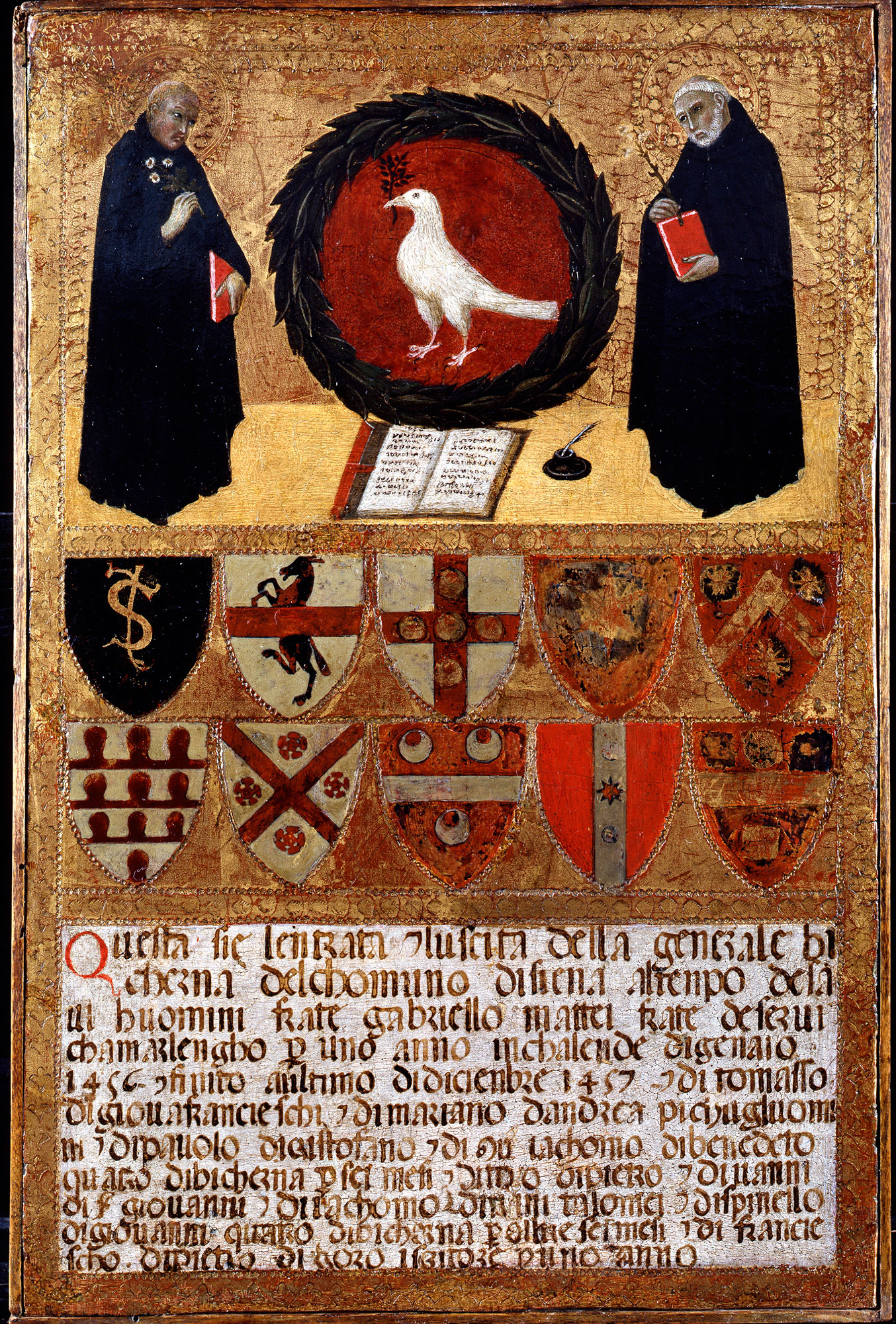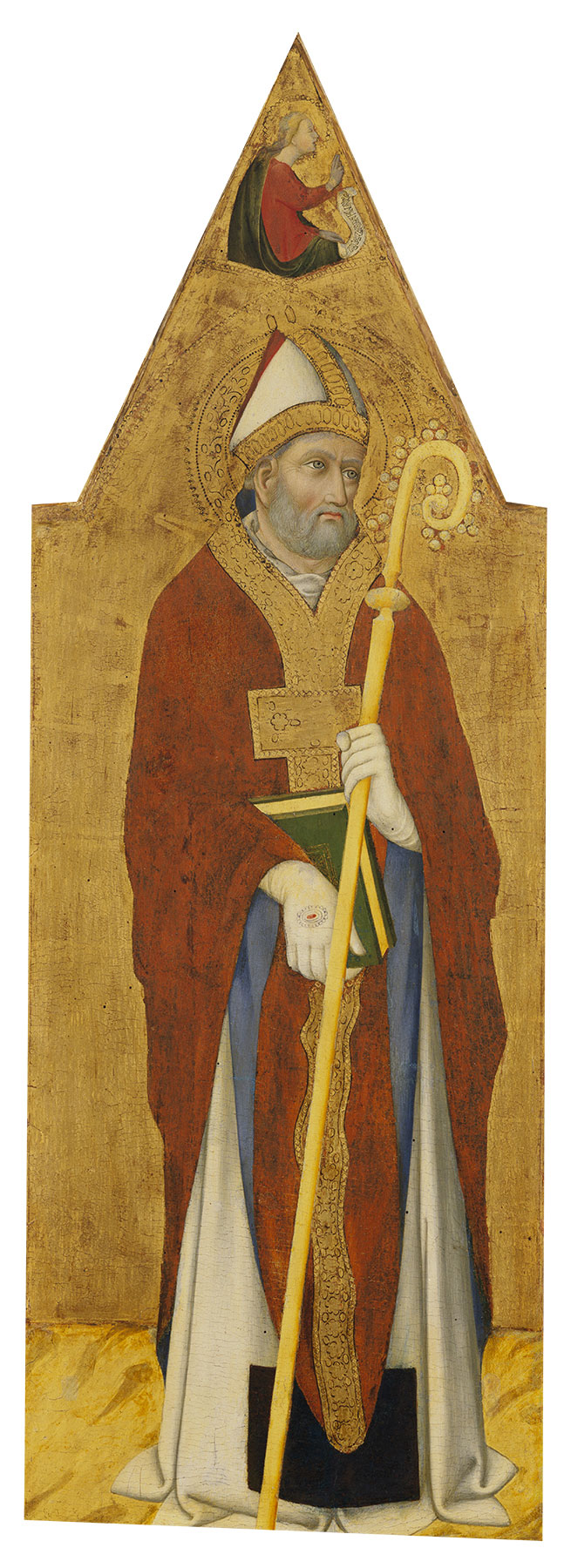James Jackson Jarves (1818–1888), Florence, by 1859
The panel support, of a horizontal wood grain, has been thinned to 9 millimeters, waxed, and cradled. Two partial splits at the level of the executioner’s waist and the bishop saint’s thighs emanate from a large knot in the wood, also visible as a vertical check in the foremost red shield of the phalanx of Roman soldiers. The paint surface is beautifully preserved although dulled by a grayed synthetic varnish. Losses are chiefly confined to the edges of the panel, the largest appearing in the two upper corners. The faces of the prefect and soldiers at the left have been scratched, and the gilding of the saint’s halo is abraded and broken by flaking losses. The silver-leaf upper and lower margins of the composition have tarnished and are abraded to the red bolus preparatory layer beneath.
Like most paintings by Sano di Pietro, the Yale Martyrdom of Saint Donatus has a brief and relatively uninformative critical history. It entered the collection with an attribution to Giovanni di Paolo, assigned to it by its previous owner, James Jackson Jarves. F. Mason Perkins distinguished it from the other panel in Jarves’s collection given to Giovanni di Paolo, assigning the Martyrdom to Pellegrino di Mariano.1 William Rankin thought it looked closer to Sano di Pietro, and this opinion was seconded by Osvald Sirén.2 It appears in all editions of Bernard Berenson’s lists under Giovanni di Paolo’s name,3 and Joseph Breck also published it as by Giovanni di Paolo, although he observed that, in this case, the artist was approximating the manner of Sano di Pietro.4 Raimond van Marle, who evidently never saw the painting, included it twice: once as Giovanni di Paolo and once as a follower of Sano di Pietro.5 Following John Pope-Hennessy’s dismissal of the painting as by an anonymous Sienese artist, wrongly ascribed to Giovanni di Paolo, it was referred to consistently as by or in the style of Sano di Pietro (with the exception of Berenson’s 1968 lists).6 Everett Fahy, in his manuscript annotations to Charles Seymour, Jr.’s 1970 catalogue of the Yale collection, recorded the opinion of Creighton Gilbert that a predella panel by Sano di Pietro exhibited at Brandeis University in 1983—lent from the collection of T. S. Hyland, in Greenwich, Connecticut—might be a companion to the Yale panel.7 This observation was confirmed by Keith Christiansen when the former Hyland panel appeared at auction at Sotheby’s, London (fig. 1).8 The two works are very nearly the same size (the ex-Hyland panel measures 21.8 × 36 cm), and both display an identical line of simple dot punches on a silver ground at their upper and lower edges.

The predella panel formerly in the Hyland collection represents an episode in the life of Saint Donatus, a fourth-century bishop of Arezzo. According to the Golden Legend, “A certain spring was so polluted that anyone who drank from it died immediately. Saint Donatus, mounted on his ass, was passing that way and purified the water by his prayer, whereupon a frightful dragon burst out of the spring, coiled its tail around the ass’s legs, and reared itself up against Donatus. The saint struck the beast with his whip . . . and killed it. He also prayed to the Lord, and all the poison was gone from the spring.”9 In the Hyland panel, the dragon has apparently emerged from the mouth of a cave before a river or pool at the left. Donatus, mounted on a horse rather than an ass and wearing his bishop’s miter and a rose-colored cope over a white surplice, swings a knotted whip at the dragon. The two animals and the holy bishop occupy nearly the full height and width of the panel in the foreground. In the Yale panel, a bishop wearing the same colors kneels before an executioner who swings back his sword, its discarded sheath on the ground between his legs. A group of soldiers at the left and a single soldier at the right carry large red shields emblazoned with a scorpion device. The commander of the troop at the left, dressed in blue over his gilded armor, presumably is meant to be the prefect Evadracianus, who ordered the saint’s beheading.
A more developed and more colorful version of the story of Saint Donatus and the dragon was included by Sano di Pietro in the predella to his altarpiece of 1476 in the church of Santi Salvatore e Cirino at Badia a Isola, in which, among other minor changes, two bystanders in secular dress are added behind Saint Donatus at the right (fig. 2). The simplified composition of the ex-Hyland panel does not necessarily indicate a later date for it but may imply a less prominent public destination for the original commission. Sano di Pietro’s stylistic development was gradual, and his output, following the demands of his patrons, relatively uniform, so assigning specific dates to paintings by him that lack documentation is difficult. Christiansen proposed a date around 1460 for the ex-Hyland panel, and this seems appropriate as well for the Yale Martyrdom. The figures in both panels compare closely to those, painted on a similar scale, in Sano’s biccherna cover of 1457 representing two Servite Blesseds, Giovacchino Piccolomini and Francesco Patrizi (fig. 3). The spare, reduced landscape settings in both panels recall those in the manuscript illuminations by Sano from the cathedral of Pienza, painted between 1460 and 1462.


In the Badia a Isola predella (see fig. 2), the story of Saint Donatus is accompanied by three unrelated scenes, each drawn from the legend of the saint portrayed in the altarpiece above it. It is possible, therefore, that if it came from a similar altarpiece, the Yale panel does not represent the martyrdom of Saint Donatus but of another holy bishop. However, the similarity of dress between the bishops in the Yale and ex-Hyland panels suggests the greater likelihood that both are scenes from the story of the same saint, and in that case, the altarpiece in which they were included must have borne a special dedication to Donatus, probably following either the dedication of its church or the name of its locality. No other panels by Sano di Pietro of the same size, style, and marginal decoration as these two have yet been discovered that might have come from the same predella.
Although Sano di Pietro was a highly prolific artist, the number of altarpieces by him disassociated from their predellas and of predella fragments in search of an altarpiece is surprisingly small. Few of these altarpieces include a bishop saint not otherwise specifically identified by an attribute or an inscription who could perhaps be Saint Donatus. One such altarpiece, Polyptych 231 in the Pinacoteca Nazionale, Siena, includes a bishop saint invariably identified as Augustine in its rightmost lateral panel. As the figure wears black robes beneath his cope, this identification is probably correct. Another bishop saint conventionally identified as Augustine, from an altarpiece of which only two panels survive, both now in the Kress Collection at the Birmingham Museum of Art, Alabama (fig. 4), is instead dressed in white beneath his vermillion cope and might well have been intended to represent Donatus.10 The style and dimensions (118.1 × 41.1 cm) of the Birmingham saint are consonant with those of the Yale predella, supporting—although not demonstrating—the possibility of their reconstruction as parts of a single structure. The Birmingham Saints, whose backgrounds have been regilt, include half-length figures of the Annunciatory Angel and Virgin Annunciate in their gables. It is unclear whether they originally formed part of a triptych or pentaptych; neither the Virgin and Child that must once have stood between them nor a further pair of saints that might have stood alongside them have been identified.

Aside from his prominence as protector saint of Arezzo, Donatus was the name-saint of numerous churches and small towns throughout Tuscany, including two within the walls of Siena: Sano di Pietro’s own parish church and the church of San Michele a Monte San Donato. The latter, now secularized and owned by the Monte dei Paschi di Siena, was built in the twelfth century and attached to a Vallombrosan monastery, since destroyed. Perhaps significantly, the bishop saint, possibly Donatus, in Birmingham, is accompanied by a full-length figure of Saint Benedict in a dark gray habit (fig. 5), which has suggested to some scholars that “the altarpiece to which the panels belonged may have been commissioned for a chapel or church associated with the Vallombrosan Order.”11 Gaudenz Freuler has, probably correctly, identified seven fragments of an altarpiece by Luca di Tommè that may have been painted for this church shortly after 1350.12 In his pastoral visit of 1575, Monsignor Francesco Bossi listed nine altars in this church, each provided with a painted altarpiece. He recorded three further altars with paintings in the parish church of San Donato, but none are described in sufficient detail to allow an identification with Sano di Pietro’s predella panels.13 —LK

Published References
Jarves, James Jackson. Descriptive Catalogue of “Old Masters” Collected by James J. Jarves to Illustrate the History of Painting from A.D. 1200 to the Best Periods of Italian Art. Cambridge, Mass.: H. O. Houghton, 1860., 48, no. 50; Sturgis, Russell, Jr. Manual of the Jarves Collection of Early Italian Pictures. New Haven: Yale College, 1868., 55, no. 52; W. F. Brown, Boston. Catalogue of the Jarves Collection of Early Italian Pictures. Sale cat. November 9, 1871., 19, no. 52; Perkins, F. Mason. “Pitture senesi negli Stati Uniti.” Rassegna d’arte senese 1 (1905): 74–78., 77; Rankin, William. Notes on the Collections of Old Masters at Yale University, the Boston Museum of Fine Arts, the Fogg Museum of Harvard University. Wellesley, Mass.: Department of Art, Wellesley College, 1905., 10, no. 52; Berenson, Bernhard [sic]. The Central Italian Painters of the Renaissance. New York: G. P. Putnam’s Sons, 1911., 178; Breck, Joseph. “Some Paintings by Giovanni di Paolo—I.” Art in America 2, no. 3 (April 1914): 177–86., 177, 179–80; Sirén, Osvald. A Descriptive Catalogue of the Pictures in the Jarves Collection Belonging to Yale University. New Haven: Yale University Press, 1916., 159–60, no. 62; van Marle, Raimond. The Development of the Italian Schools of Painting. Vol. 9. The Hague: M. Nijhoff, 1927., 451–52n2, 527–32n2; Berenson, Bernard. Italian Pictures of the Renaissance: A List of the Principal Artists and Their Works with an Index of Places. Oxford: Clarendon, 1932., 246; Pope-Hennessy, John. Giovanni di Paolo, 1403–1483. London: Chatto and Windus, 1937., 159, 165n27; Berenson, Bernard. Italian Pictures of the Renaissance, A List of the Principal Artists and Their Works with an Index of Places: Central Italian and North Italian Schools. 3 vols. London: Phaidon, 1968., 1:178; Seymour, Charles, Jr. Early Italian Paintings in the Yale University Art Gallery. New Haven: Yale University Art Gallery, 1970., 204–5, 320, no. 154; Fredericksen, Burton B., and Federico Zeri. Census of Pre-Nineteenth-Century Italian Paintings in North American Public Collections. Cambridge, Mass.: Harvard University Press, 1972., 182, 599
Notes
-
Perkins, F. Mason. “Pitture senesi negli Stati Uniti.” Rassegna d’arte senese 1 (1905): 74–78., 76–77. For the other panel in the Jarves collection, see Yale University Art Gallery, inv. no. 1871.59, https://artgallery.yale.edu/collections/objects/319. ↩︎
-
Rankin, William. Notes on the Collections of Old Masters at Yale University, the Boston Museum of Fine Arts, the Fogg Museum of Harvard University. Wellesley, Mass.: Department of Art, Wellesley College, 1905., 10, no. 52; and Sirén, Osvald. A Descriptive Catalogue of the Pictures in the Jarves Collection Belonging to Yale University. New Haven: Yale University Press, 1916., 159–60, no. 62. ↩︎
-
Berenson, Bernard. The Central Italian Painters of the Renaissance. 2nd rev. ed. New York: G. P. Putnam’s Sons, 1909., 178; Berenson, Bernard. Italian Pictures of the Renaissance: A List of the Principal Artists and Their Works with an Index of Places. Oxford: Clarendon, 1932., 246; and Berenson, Bernard. Italian Pictures of the Renaissance, A List of the Principal Artists and Their Works with an Index of Places: Central Italian and North Italian Schools. 3 vols. London: Phaidon, 1968., 1:178. ↩︎
-
Breck, Joseph. “Some Paintings by Giovanni di Paolo—I.” Art in America 2, no. 3 (April 1914): 177–86., 177, 179–80. ↩︎
-
van Marle, Raimond. The Development of the Italian Schools of Painting. Vol. 9. The Hague: M. Nijhoff, 1927., 452n, 532n. ↩︎
-
Pope-Hennessy, John. Giovanni di Paolo, 1403–1483. London: Chatto and Windus, 1937., 159, 165n27. ↩︎
-
See curatorial files, Department of European Art, Yale University Art Gallery. ↩︎
-
Sotheby’s, London, July 3, 2019, lot 2. ↩︎
-
de Voragine, Jacobus. The Golden Legend. Trans. William Granger Ryan. 2 vols. Princeton, N.J.: Princeton University Press, 1993., 60. ↩︎
-
In Roberts, Perri Lee. Corpus of Early Italian Paintings in North American Collections: The South. 3 vols. Athens: Georgia Museum of Art, 2009., 1:134–35, and in all earlier literature, he is identified as Saint Augustine. ↩︎
-
Roberts, Perri Lee. Corpus of Early Italian Paintings in North American Collections: The South. 3 vols. Athens: Georgia Museum of Art, 2009., 1:134. ↩︎
-
Freuler, Gaudenz. “L’eredità di Pietro Lorenzetti verso il 1350: Novità per Biagio di Goro, Niccolo di Sozzo e Luca di Tommè.” Nuovi studi 4, no. 2 (1997): 15–32., 15–32. Although rejected by Freuler, the predella in the Yale University Art Gallery (see Luca di Tommè, Predella: Saint Francis, the Mourning Virgin, Christ on the Cross, the Mourning Saint John the Evangelist, and Saint Dominic) was probably part of this altarpiece. ↩︎
-
Bossi, Francesco. Visita apostolica alla diocesi di Siena, 1575. Vol. 1, Ecclesiae. Transcribed by Giuliano Catoni and Sonia Fineschi. Siena: Accademia Degli Intronati, 2018., 108–9, 161–62. ↩︎